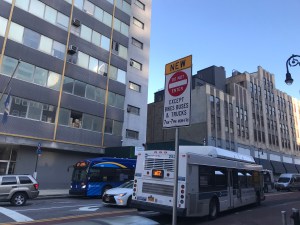After the Service Cuts: Riders Cram on to Overburdened, Unreliable B61

Toward the end of a press conference at the corner of Fourth Avenue and 9th Street this morning, Council Member Brad Lander remarked that not a single B61 bus came by during the 15-minute event. This was only fitting, since Lander was unveiling a new report from his office that found most rush hour B61 buses don’t arrive within the guidelines established by the MTA.
During rush hours, the B61 is supposed to arrive every eight to ten minutes, but the service is anything but reliable, according to the report, “Next Bus Please.” Fully 57 percent of buses are either spaced at least three minutes farther apart than they’re supposed to be, or bunched at least three minutes tighter together. For straphangers this translates into long waits, crowded buses, and the frustration of watching an empty B61 pull up right as you’re boarding that jam-packed bus.
“It gets really packed every morning,” said Vian Hernandez, a senior at South Brooklyn Community High School in Red Hook, who transfers from the train to the B61 to get to school. “Sometimes it comes really late.”
The current B61 route is the byproduct of the 2010 MTA service cuts (themselves a byproduct of Albany budget raids, the mounting cost of MTA debt service, and the collapse of the real estate market). The line was extended east from Red Hook to Park Slope and Windsor Terrace, absorbing passengers who used to take the now-defunct B75 and B77. The nearby B37 and B71, which served parallel routes, were also eliminated, and the Smith-9th Street subway stop has been closed for maintenance since June, further increasing reliance on the B61.
A year and a half after the cuts took effect, the study from Lander, Congresswoman Nydia Velazquez, and City Council Member Sara Gonzalez documents the strain on the riders who depend on this line, which is now the only bus or subway route that directly serves Red Hook.
Service seems to be deteriorating. A November, 2010 New York City Transit study of the B61 found that 36 percent of buses were arriving outside the MTA’s service guidelines. While NYCT was looking at all buses, not just rush hour service, the authors of “Next Bus Please” say their measurements — 57 percent of rush hour buses failing to meet the guidelines — indicate things have gotten worse on the B61 since then.
They outline a package of improvements for the bus line, including additional peak-hour service, limited stop service for the most popular stops, real-time arrival info, and better contingency routes in the event that a ship passes through the Gowanus Canal at the 9th Street Bridge, a drawbridge that can delay B61s for up to 15 minutes.
Some of those recommendations should come at little or no cost to the financially strapped MTA. (One recommendation, for instance, calls for merging bus stops that are too close together, which could actually cut the cost of operating the B61.) While adding peak hour service won’t be free, the MTA has restored service on several lines since the 2010 cuts in response to rider demand and political pressure. “Next Bus Please” is, I believe, the most rigorous and thorough attempt to document why additional service would benefit a specific bus line.
Velazquez said that Red Hook’s dependence on the B61 justifies the increased service. “The MTA has to prioritize needs,” she said. “Red Hook suffers from a lack of transportation options.”
The authors have shown the report to the MTA and are awaiting a response.
